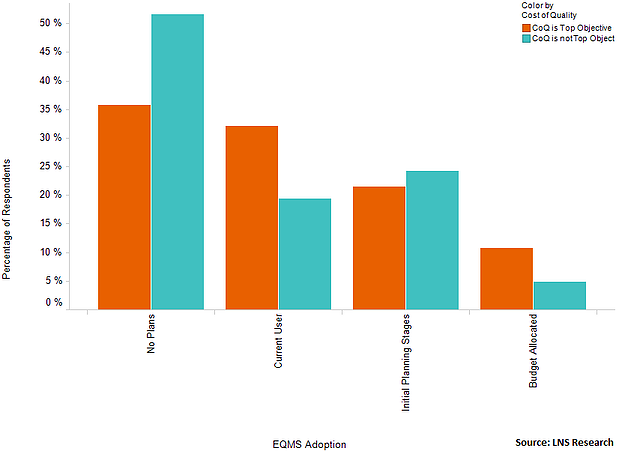Last week, we shared some of our most recent quality management data. Our post Cost of Quality: More than Risk and Compliance discussed the relationship between quality management objectives, financial objectives, and whether or not companies choose to measure the cost of quality. The results were intriguing, prompting us to take a deeper look into the cost of quality metric and its correlation with other variables.
Enterprise Quality Management Software (EQMS) can play a vital role in both the analysis and reduction of the cost of quality. Companies may use EQMS as a platform for cross-functional communication and collaboration, but also for automating, standardizing, and centralizing quality processes. The software allows executives to make better decisions based on real time information.
With that said, we’re interested in the connection between quality management objectives and EQMS adoption. In this post, we’ll dive into our data to see if there are any correlations.
Top Quality Management Objectives
Out of the more than 400 quality management survey respondents, 35% say that reducing the cost of quality is their company’s top quality management objective. This is significantly larger than the following choices: improve customer experience (19%), reduce non-conformances in manufacturing (13%), preserve brand equity (11%), and better manage operational risks (8%).

Given that the cost of quality can be viewed as a holistic business measurement, this is not surprising. Reducing the cost of quality and its many sub-variables can drive improvements in customer experience, non-conformances, brand equity, and other quality management objectives.
Also, as discussed in last week's post, measuring cost of quality can help to grow revenue over time.
Cost of Quality and EQMS Adoption
Separately, we asked executives about the status of their EQMS adoption. The choices ranged from no plans to current user, initial planning stages, and budget allocated. Interested in finding out the connection between the objective of reducing the cost of quality and current phases of EQMS adoption, we analyzed the two questions together.

Based on the data, companies that choose reducing the cost of quality as a top objective are far more likely to currently be using an EQMS or have budget allocated. What’s very interesting is that more than 50% of companies having a top quality management objective other than reducing the cost of quality have no plans for implementing an EQMS system.
Driving Business Performance with EQMS
A majority of executives who choose the cost of quality as a top quality management objective, at the very least, have an EQMS system in mind. This may indicate that these executives have a better understanding of how the cost of quality plays into quality management and EQMS. It may also imply that the surveyed companies are more mature, possibly approaching the point where it makes sense to adopt an EQMS system to help measure the complex cost of quality equation.
At LNS Research, we advocate for quality management to be integrated throughout the value chain. Many market leading companies can attest to the fact that, when leveraged correctly, both EQMS and the cost of quality can bring an enterprise perspective into quality management decisions.
If measuring the cost of quality or implementing an EQMS seems infeasible or overwhelming right now, you may want to consider reading our materials "EQMS Best Practices Guide" and "Cost of Quality as a Holistic Business Measurement" for more information.
You might also be interested in:
Cost of Quality Metric: The Formulation Management
Cost of Poor Quality Definition
Cost of Quality Definition